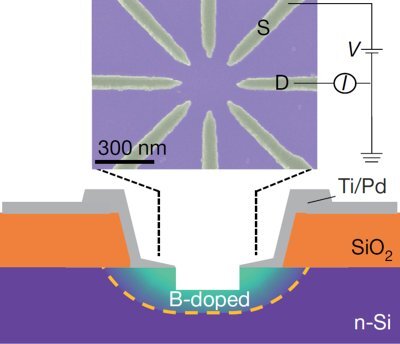by W.r. Van Der Veen,

A disordered network that is capable of detecting ordered patterns: This sounds contradictory, but it comes close to describing the way the brain works. Researchers of the University of Twente have developed a such brain-inspired network based on silicon technology that can be operated at room temperature. It makes use of material properties that electronic designers usually like to avoid. Thanks to "hopping conduction," the system evolves to a solution without making use of predesigned elements. The researchers publish their work in Nature on January 15, 2020.
The brain is very good at recognizing patterns. Artificial intelligence can do better in some cases, but this comes with a price: It takes massive computing power, whereas the brain only consumes 20 watts.
The semiconductor industry is now embracing new computer design strategies inspired by the brain function, like Intel's Loihi processor, which has neurons and synapses. Still, mimicking one single neuron takes thousands of transistors—and the brain has tens of billions of neurons. Miniaturization is one approach to this scale, but the technology is reaching physical limits. The new disordered dopant atom network, now presented in Nature is a different approach: It doesn't use predesigned neurons or other circuitry, but makes use of material properties to evolve toward a solution. This highly counterintuitive approach is energy efficient and doesn't occupy much surface space.
Hopping
In electronics, doping is a well-known way of influencing the properties of transistors by deliberately introducing impurities into the silicon crystal in a concentration high enough to achieve the desired effect. In this case, using a much lower concentration of boron results in a regime that circuit designers prefer to avoid.
That's exactly the regime in which the disordered network operates. Conduction now takes place via electrons hopping from one boron atom to another: This 'hopping conduction' is, in a way, comparable to neurons seeking collaboration with other neurons to make a classification. As an example, the network is fed with 16 basic, four-digit patterns. Each pattern results in a different output signal. With these 16 as a basis, it is possible to recognize a database with handwritten letters with high accuracy and speed, for example. The basic component is now 300 nanometers in diameter, has about 100 boron atoms and consumes about 1 microWatt of power.
In future systems that use this type of network, pattern recognition can be done locally, without using distant computing power. In autonomous driving, for example, many decisions have to be made based on recognition. This involves either a powerful onboard computer system or high-bandwith communication with the cloud, probably even both. The new brain-inspired approach would involve less transport of data, so the car manufacturing industry is already interested in the new UT approach. This type of computing, called "edge computing," can also be used for face detection, for example.
The paper, "Classification with a disordered dopant atom network in silicon," is published in Nature. In the same issue, there is a related review titled "Evolution of circuits for machine learning."
More information: Tao Chen et al. Classification with a disordered dopant-atom network in silicon, Nature (2020). DOI: 10.1038/s41586-019-1901-0
Citation: Brain-like network uses disorder to detect order (2020, January 16) retrieved 16 January 2020 from https://techxplore.com/news/2020-01-brain-like-network-disorder.html
This document is subject to copyright. Apart from any fair dealing for the purpose of private study or research, no part may be reproduced without the written permission. The content is provided for information purposes only.
